This post is intended as an archive of the projects created in the fiber arts class I designed for the Family Learning Program. Taught weekly at the Southwest Teen Life Center in West Seattle, the Family Learning Program was established to provide curriculum enrichment to homeschool families.
Week 1: Sewing

We started our class with the most basic skills needed in a hand sewing class. Students practiced threading needles with yarn and embroidery floss, tying knots at the end of their thread and sewing buttons onto recycled wool felt.
Week 2: Sewing

In week 2, students created pouches with buttons and handles.

They worked with manufactured wool felt, sewing side seams, handles and buttons with wool tapestry yarn.
Week 3: Needlepoint

In the third week, we worked on needlepoint using rigid plastic grids. Students were shown how to do the simplest over-under-over stitch, which leaves some of the plastic grid visible.
To further explore this idea, plastic grids are sold in 10″ x 13″ sheets at craft stores. Cut a grid into six pieces, fill each grid with needlepoint and then stitch them together to create a box or a tote.

We used wool yarn for this project as it will expand to fill the gaps between the grid lines nicely, but needlepoint is typically done with either wool tapestry yarn, cotton or silk floss. Separate the strands for fine color work.
For students ready for a further challenge, try stitching on gingham fabric, using the colored grid as a guide or move on to traditional needlepoint fabric which has a fine grid built into the weave. Draw a pattern on the fabric with colored markers, then follow the color changes with the floss. Some people find it is easier to handle fabric when held taught by an embroidery hoop, but this can be cumbersome and more difficult for some hands to manage. We started with plastic grids so students could focus on their stitching instead of worrying about keeping the fabric stable.
Recommend reading: Kids’ Embroidery by Kristin Nicolas
Week 4: Weaving

Students wove strips of recycled maps through scored cards. Some students created an alternating basketweave pattern, while another wove the same over-under pattern for each strip. The basketweave creates a tight construction, while placing all strips in the same slots creates a pattern with more movement.
Recommended reading: Kids Weaving by Sarah Swett
Week 5: Kumihimo (Japanese Braiding)

Working on a smaller scale, students replicated an ancient process used to create heavy cord and rope. Students plied a seven strand braid using a cardboard octagon disc. The finished braid can be used as a friendship bracelet, a strap or an ornament.
The kumihimo discs were made with matte board. The slots will bend and wear out over time. To recreate your own disc, cut a square of stiff cardboard. On each side, measure and mark 1/4, and 3/4 of the width. Cut the corners between the 1/4 and 3/4 mark. This will create an octagon. Cut a slit halfway through each side, and poke a hole through the center with an awl. Cut seven lengths of yarn or cotton cord; pull the seven strands through the hole and knot together. Slip one piece of yarn through seven of the slots. From the empty slot, count 1…2…3. Pull the 3rd strand out of the slot and place it in the empty slot. Rotate the disc so the empty slot is now in front of you and count again 1…2…3. Make sure you are always working in the same direction (it doesn’t matter which) or you will undo the braid.
I read Farmer Brown Shears His Sheep by Teri Sloat in which a farmer shears his sheep, then takes the wool to be washed, carded, dyed and spun into yarn so he can knit colorful sweaters for the sheep. The students love the whimsical illustrations.
Week 6: Wetfelting
We jumped into my favorite subject this week: making felt from wool. I showed the students raw wool in the grease, and the same locks once washed. Then I demonstrated how the locks are turned into batt using hand carders.

Next we laid out small pieces of merino batt on 10″ squares of batt I had previously cut. Dyed locks, yarn and small pieces of pre-felt were also available as additional embellishments. I chose to use batt to minimize the difficulties young students have with drafting fine layers of roving.

Once the design was complete, we placed them on a 12″ square of bubble wrap, then slipped the batts into a ziploc bag, squirted in some warm soapy water, then sealed. We pounded the bags with our hands, rubbed the wool around on the bubble wrap and stomped on the floor. After ten minutes of vigorous agitation, we opened the bags to see how the felt was progressing. We poured a little more hot water on the felt, then rubbed some more. Once I determined the felt was finished, we rinsed and squeezed out the excess water.

With a few minutes left in the class, I read Noah’s Mittens by Lise Lunge-Larsen. It is the only picture book about felting I know. It is a clever story that describes the effect of heat and friction on sheep in close quarters and the felt that results. Caveat: as the author relies on the story of Noah’s ark as the springboard to describe the discovery of felt, there are several God references, which I didn’t have the forethought to edit as I was reading aloud.
Recommended reading: The Art of Feltmaking by Anne Einset-Vickrey
Week 7: Sewing and Spinning
We started the class reading Feeding the Sheep by Leda Schubert, a sweet sheep-to-sweater story where a child learns why her mother cares for her sheep.

As an introduction to spinning, we twisted and then plied a short piece of yarn. While one student held the end of the roving, the other student twisted until it the wool started to twist back on itself. The process was repeated with a second piece of roving. Holding the two pieces of roving together in one hand, I released the potential energy coiled within and the two bits twisted around each other.

The students worked on sewing lavender sachets, which can double as small pillows for their stuffies and dolls. Using small pieces of cotton fabric, I pinned two pieces together wrong sides out, then the students whip stitched them together with wool tapestry yarn.

Once they were finished stitching on three sides, we flipped them so the right sides were facing out then filled them with a mixture of rice, lentils and lavender. One more seam along the open side finished them off.
Week 8: Wetfelting Jellyroll Beads
We worked on another felting project this week: jellyroll beads. This project demonstrates just how firm and dense felt can become, despite starting with light and fluffy wool. Students selected three sections of merino roving in different colors, then drafted small sheets into an aluminum pan, creating a striated stack. Just like preparing sushi, students rolled their stack of wool tightly into a cylinder. With a drizzle of soapy water in their pan, they rolled the cylinder of fluffy wool gently, being careful not to saturate the wool all at once. Over time, they increased the pressure on the cylinder until it was time to put all their strength into compressing the last bit of wool into felt.

As we were working on plastic folding tables, it was difficult to get any traction on the surface. The cylinders did a lot of slipping and not much rolling. Working on a non-slip, textured surface will help in the final stages of felting. As I neglected to bring them in, I took the students’ felt logs back to the studio to finish. We will cut the beads next week.
At my studio, I work on a corrugated vinyl mat from the flooring department of your local home improvement store. I place the mat on a square of shelf/drawer liner also sold in home improvement stores to keep your dishes or silverware trays from sliding around. When the cylinders were firm and dense, I rinse out all the soap, then squeeze out the excess water.
Karen read Sophie’s Masterpiece by Eileen Spinelli while we worked on the jellyroll beads.
Week 9: Sewing Gnomes
In our last week together, we cut our felt jellyroll beads from last week and sewed tiny felt gnomes using industrial wool felt, carded wool batting, wool tapestry yarn and tiny bells. The pattern is from Freya Jaffke’s classic Waldorf book: Toymaking with Children.

These gnomes would make sweet little ornaments for a doorknob or tree. The pattern calls for a single row of whip stitch along the hoodline and a slip stitch around the collar. The finished gnomes are stuffed with wool batting.


One student brought her felt purse from Week 2. It was the perfect way to take home her felt gnome and jellyroll beads. I sense a color theme working through this student’s work.
There was just enough time at the end of class to read Woolbur by Leslie Helakoski.
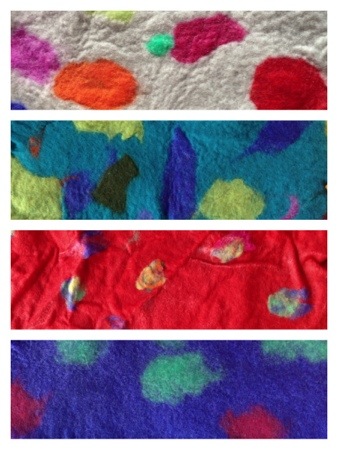
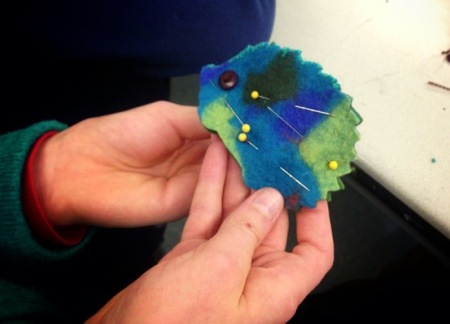
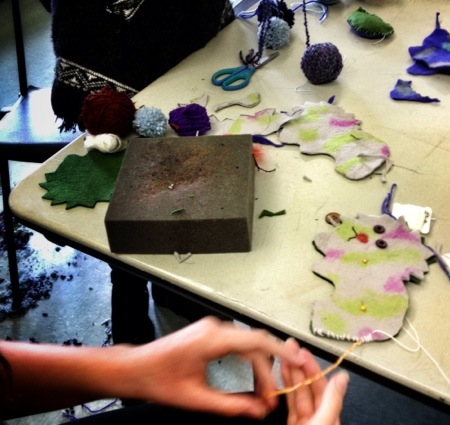
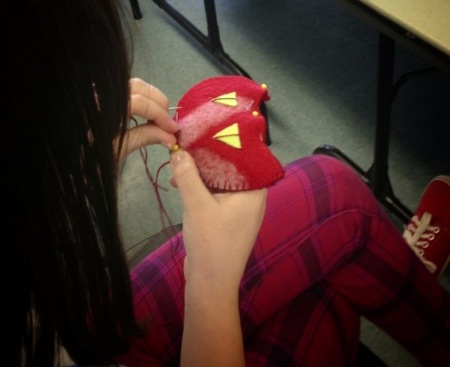




























































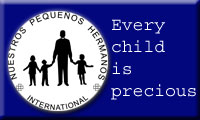

You must be logged in to post a comment.